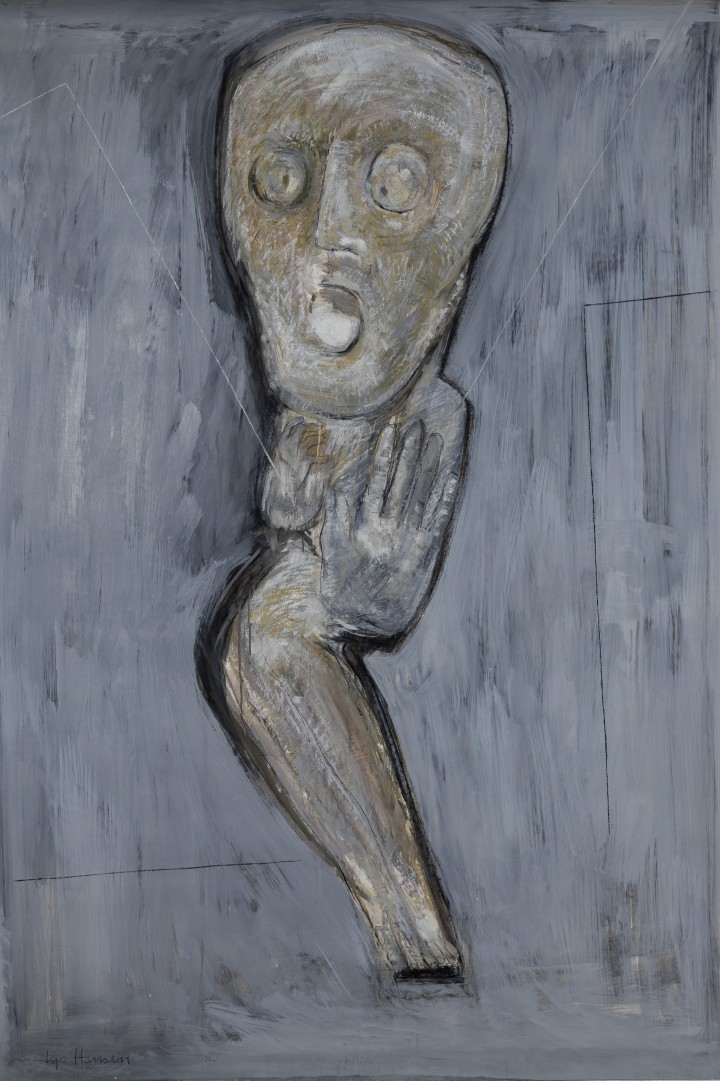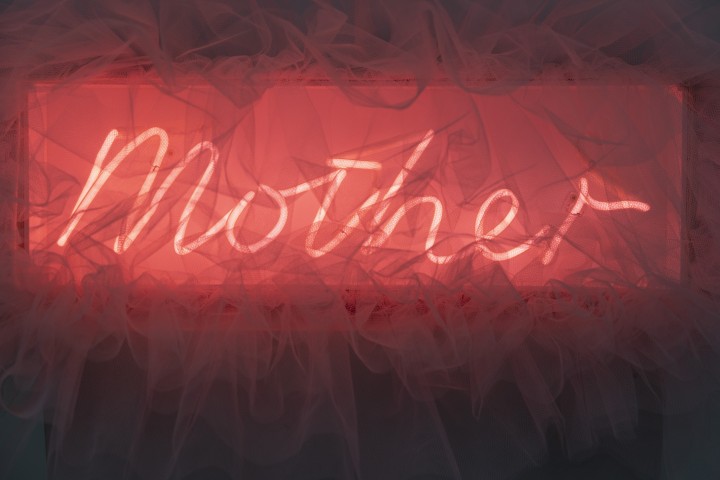Scottish Art News
Latest news
Magazine
News & Press
Publications
Lys Hansen: Live It, Paint It
By Susan Mansfield, 25.07.2024

There is plenty that’s striking about Lys Hansen’s paintings: their vigour and expressiveness, their rawness of emotion, the way they seem to fill Falkirk’s Park Gallery from floor to ceiling. Certainly, they tower over the elegant white-haired woman who has come to talk to me about them.
 Armed and Dangerous, image courtesy of the artist
Armed and Dangerous, image courtesy of the artist
But Hansen, who is now 87, has as much presence as her work. She is as frankly personal, as uncompromisingly political as her paintings. Even as a student at Edinburgh College of Art in the 1950s, she knew she didn’t want to paint still lifes or landscapes.
‘We were told to look at the pretty things in life,’ says Hansen. ‘It’s a domestication, a domestic art about pretty flowers sitting on a nice table. There are no bombs going off. Before I even started painting, I knew there was something else. I think it’s called life.’
Hansen’s chief subject is the human figure, usually nude. Her themes are motherhood, birth, death, sex, conflict, love, pain. Part Danish, she works from an expressionist tradition more closely aligned to Germany and Scandinavia than the UK. Opening the exhibition Lys Hansen: Live It, Paint It, which brings together works from the last five decades, Dr Geraldine Prince, a former governor of ECA, described her as ‘Scotland’s most distinguished, most European living artist’.
 Halt, image courtesy of the artist
Halt, image courtesy of the artist
Dr Marianne Greated, who curated the show, believes Hansen’s work has not received the recognition it deserves, partly because of her gender. ‘There has been a lot of recognition for male figurative painters and Lys was making work at a similar time. Her work is very upfront and direct and I think a woman making work like that, especially in past decades, wasn’t really acceptable or palatable to many people.’
If war is a key subject for Hansen, it’s because it is part of her earliest memories. Born in Falkirk in 1936, she grew up in Alloa during the Second World War. Her father was away fighting; her mother ran the family bakery business. At night, German planes roared up the Forth, bound for Glasgow. ‘And so, my night sky was searchlights and blackouts. How else does a child grow up?’ reflects Hansen.
‘I wasn’t always drawing; because it was wartime, there wasn’t anything to draw with. But I remember at school I used to stroke the teacher’s red ink when they had corrected my sums. There must have been something deep inside me which wanted colour. It’s still the same,’ she laughs, ‘I like stroking colours.’
 Mother, image courtesy of the artist
Mother, image courtesy of the artist
Studying painting at ECA under William Gillies and Robin Philipson, she had no female role models. ‘Joan Eardley and Anne Redpath were painting at that time, but they were remote. I think that young women in the art school were just very pretty to teach, and made nice wives, because that was what mostly happened at the end of college life.’ After she won a painting prize, she overhead one male classmate say to another: ‘Fancy giving it to a woman!’
After her painting degree, she studied Fine Art because, at that time, no combined course existed. ‘It seemed only intelligent. You’re trying to learn your position in the scheme of things, so it’s of paramount importance that you educate yourself. And as a woman, particularly, you have to go searching and finding what you need for your work. And that’s exactly what I did.’
And then she did marry, and she and her husband George Sutherland had two sons. While the expectation in the 1960s was that a woman would remain in the home, Hansen was teaching, organising local exhibitions, making her own work. ‘Because if you’re an artist, if you’re in love with art, you just can’t stop doing it. You live it, you paint it: that’s how you are.’
As her sons grew, she started to find her creative voice. ‘I think things have to happen to you before you’ve got something to say. You begin to get a sense of being a woman in the world and a mother, and what that entails. Plus you have the experience of birthing and this child growing inside you, and you realise that your body’s not your own; it’s an occupied space by the family and the husband. So all of that leads into what I was going to do.’
She felt acutely the tension between the demands of family life and the desire to make art. ‘The art thing surfaced defiantly, and therefore I had to organise my life and my priorities and this I did. I was gifted with an enormous amount of energy, I have to say that. I organised the food at weekends so that there were meals when I got home [from teaching], then I went off again to work at the studio till late. Everything is a balancing act between the teaching, your family, your artwork, trying to do all this because the need is there.’
 SAY NOTHING LYS, image courtesy of the artist
SAY NOTHING LYS, image courtesy of the artist
She was discovering she had plenty to say about the female body. ‘Kenneth Clark had brought out his famous book, The Nude: A Study in Ideal Form. I realised that my mother had had two caesarean sections and, although a beautiful woman, her body was no longer ideal. And she was one of six or seven sisters. They were formidable, these women. When the men were away at war, they had businesses, they had rolled- up money down their bras. So looking at paintings of naked women lying back on couches was not my experience of the women in my world.’
Gradually, she realised that understanding her own internal conflicts was giving her a way of understanding the world. All this fed into her instinctive, expressive painting. ‘When you’re a painter, you go deep. I saw there was a division in myself that seemed to be like a sort of civil war. And then I realised that it wasn’t just me personally, it was happening in Ireland with Irish killing Irish, and the British sending in the Army, the ongoing trauma and hate. This is important to paint.’
She would go on to address the situation in Ireland in her work, as well as the Cold War. In 1985, she got a grant from the Scottish Arts Council to spend several months in Berlin, a divided city full of checkpoints where the past lay close to the surface. ‘It’s a very naked city, the history is very naked. I was having to go through all these checkpoints. I didn’t know the language, so my senses were honing in on the atmosphere. All of this ties up with my own personal experiences, and then with my childhood and the war.’
Hansen continues: ‘I’m an artist who likes to go out there in the world and have a place. Artists have a function. Although photography and film are very good, they don’t take the place of the painter with the brush and the personal interpretation of things.’
 Visitation at the Blocks, image courtesy of the artist
Visitation at the Blocks, image courtesy of the artist
She continued to go to Berlin regularly through the next decade, making paintings such as the ‘Berlin Trilogy (1985): Say Nothing, Hear Everything, See All’, and then later works like ‘The Visitation at the Blocks’ (which features the city’s iconic Holocaust Memorial) and ‘The Trial’, about the French village of Ascq, which was the site of a massacre by the Nazis in 1944. She has also made work about the Dunblane shootings and more recent conflicts in Europe and elsewhere. In the last few months, she has made drawings about Gaza.
Marianne Greated says: ‘For me, one of the most interesting things about Lys is that her painting is still very contemporary, she’s still making new work which is cutting edge. Her work is about human interaction, conflict, turmoil, things which are at the forefront of what we’re dealing with now. One of the things I wanted to do with this show is think about her as a contemporary painter.’
Art, says Lys, is ‘the consciousness of the nation’. ‘It’s to be aware and to be conscious in the world and to say: look at this, this is what you’re doing. It’s a search for the truth. And it may not look very pretty at times. But that’s how it is. And that’s what we do.’
Lys Hansen: Live It, Paint It is exhibited until 11th August at Park Gallery, Callander House, Falkirk




